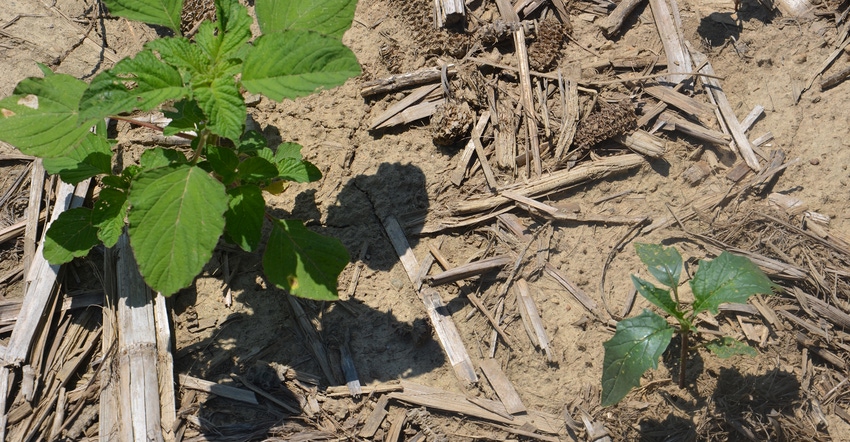
The farmer who is graciously allowing Steve Gauck to monitor his soybean field this summer for the Soybean Watch ’18 project said he didn’t have waterhemp. That was before he took a walk into the field with Gauck on a mid-July visit.
Gauck is a Beck’s sales agronomist based near Greensburg, Ind. Beck’s sponsors Soybean Watch ’18.
“Many farmers we work with have been finding [waterhemp] and fighting it already,” Gauck says. “Once it was more in the western part of the Corn Belt, but it’s definitely here now.”
Gauck pays attention to many things while scouting soybeans midseason, including effectiveness of weed control and whether any weed escapes or small, newly germinated weeds are present. That’s where this mystery began.
Same weed?
Overall weed control was good in the field. Gauck found a few small weeds germinating, primarily where there was a gap in a row. Weeds in the pigweed family can germinate well into the season.
He looked at one small plant and noted it was a typical redroot pigweed, with uneven leaf edges. But the next plant he saw, just a couple of feet away, gave him pause.
It didn’t look exactly like the first plant, but it didn’t have all the characteristics of waterhemp either. Waterhemp and redroot pigweed, along with Palmer amaranth, are all in the pigweed family.
“The leaves didn’t exactly look like redroot pigweed, but they didn’t have all the traits you would expect to find on waterhemp either,” he recalls. “The leaves didn’t have hairs, which is typical of waterhemp. Edges were smoother than the redroot pigweed plant, but not as smooth as most waterhemp plants. It definitely wasn’t Palmer amaranth because the petiole which connects the leaf to the stem was much shorter than on an amaranth plant.”
So what was it? Gauck kept looking and found more plants that were obviously redroot pigweeds, but also some plants that didn’t look exactly like pigweeds but weren’t shining examples of waterhemp either.
Smoking gun
As Gauck and the farmer headed back toward the barn lot, he wasn’t ready to tell the farmer he had waterhemp — not yet. Then he stumbled across a larger plant that obviously had been sprayed and stunted, but then regrew.
There was no mistaking this one, he says. It was waterhemp. Soon he found another one just like it.
 MYSTERY SOLVED: When agronomist Steve Gauck found this waterhemp plant on the way out of the field, he knew some of the plants he had seen earlier were likely pigweed-waterhemp crosses.
MYSTERY SOLVED: When agronomist Steve Gauck found this waterhemp plant on the way out of the field, he knew some of the plants he had seen earlier were likely pigweed-waterhemp crosses.

While it’s not the news he likes to give a farmer, he told his host there was waterhemp in the field. And the plants that weren’t quite pigweed or waterhemp? Gauck suspected they were likely crosses of pigweed and waterhemp since he finally found waterhemp in the field. Weed specialists later confirmed that it’s possible to get these kinds of crosses.
The farmer’s question was no surprise: What could he do about waterhemp in the future? Gauck’s advice was to assume he had waterhemp in every field. Based on that assumption, move to a residual herbicide program that is strong on waterhemp ahead of soybeans in 2019. He says many Class 15 herbicides based on site of action have good activity on waterhemp.
“Those escapes will make seed,” Gauck says. “The best policy is to assume it’s out there and plan for it.”
About the Author(s)
You May Also Like




